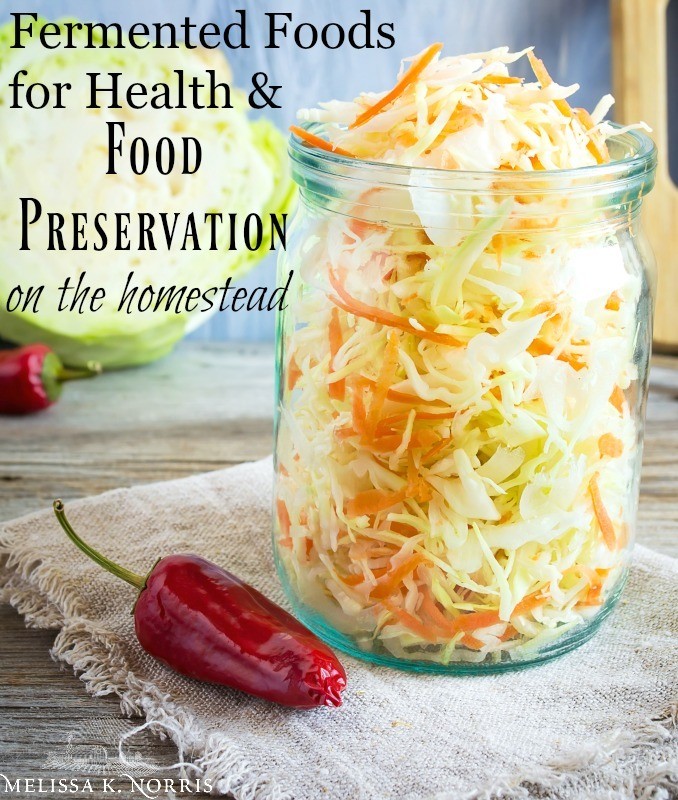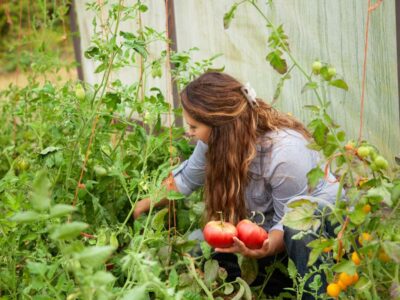If you’ve been curious about fermenting, how it actually works, what the true health benefits are, and more, then you, my friend, are in for a treat today. The health benefits of fermented food go beyond gut health. Learn how this natural preservation method improves overall health.
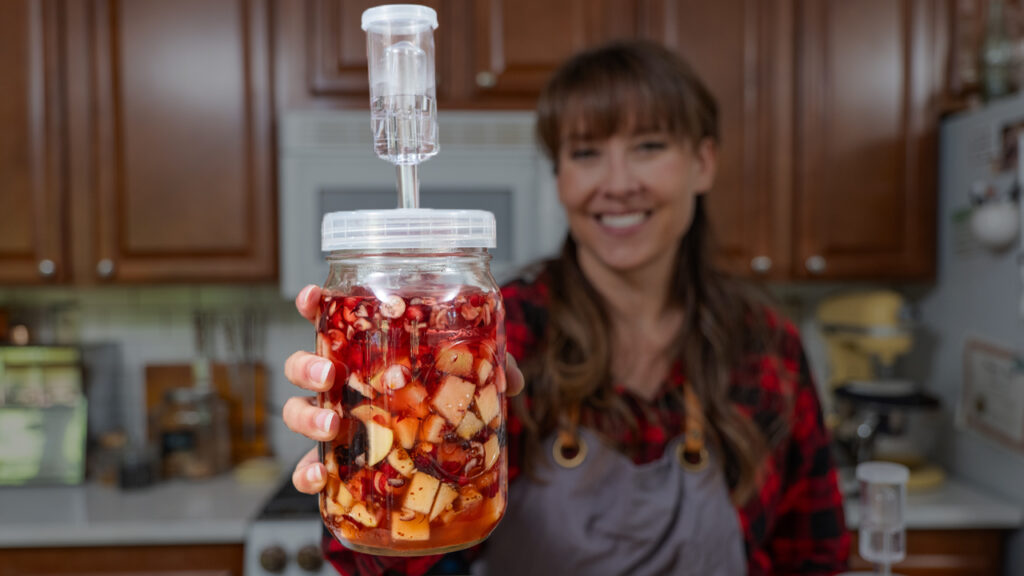
Fermentation has been around for thousands of years and is making a comeback in modern society.
Thankfully, eating fermented foods is quickly growing again and has even become, dare I say it, somewhat trendy. Now you can make fermented soybeans to kefir, to sourdough bread at home. Here’s to homesteading stuff crossing over to the mainstream!
I’ve brought on Carolyn Thomas from Homesteading Family to the podcast. She is a mother of 11 children and has mastered feeding lots of mouths with healthy, homegrown food.
Listen to Fermentation for Health Benefits & Food Preservation, Episode #145 of the Pioneering Today Podcast, where we teach families how to grow, preserve and cook their own food using old-fashioned skill sets and wisdom to create a natural self-sufficient home, with or without, the homestead.
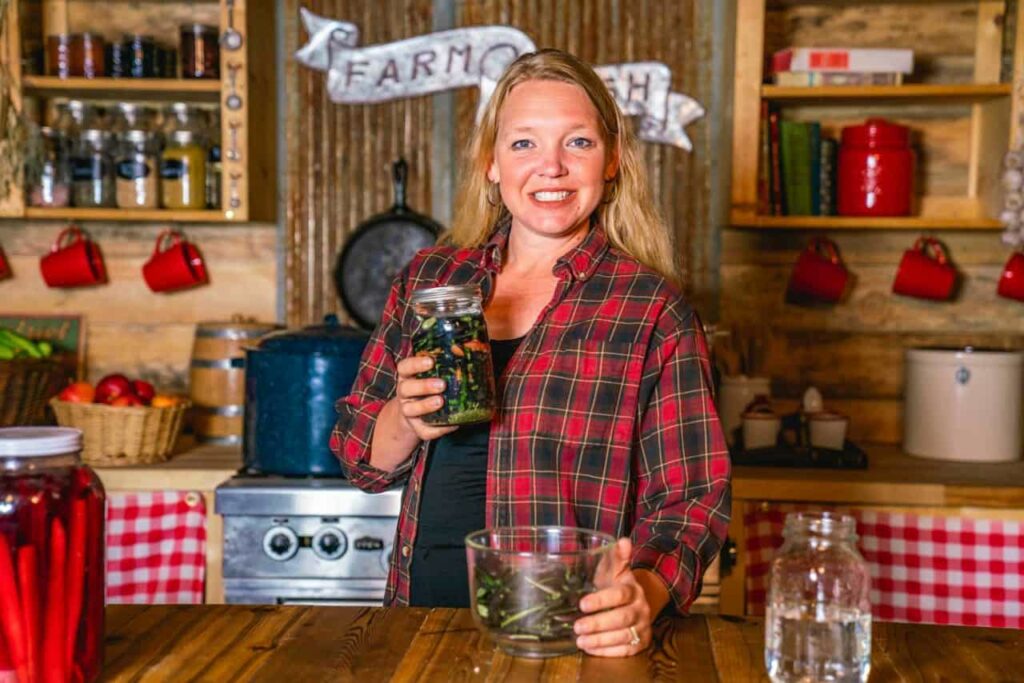
Why I Love Fermented Food
Fermentation for health benefits and food preservation stretches back thousands of years. It’s one of the earliest forms of preparing food and preserving it, yet the fermentation process is not nearly as common in modern society as canning or dehydrating.
I enjoy eating fermented foods for a couple of reasons. I know that I am preserving our fruits, veggies, and dairy products fresh from the source. I like the taste and tang of fermented foods.
I mostly like how I feel when I eat fermented foods; my gut is happier, and I feel more energetic!
Fermenting foods has become one of my favorite ways to preserve a variety of foods. My ultimate guide to fermented vegetables maximizes my cucumbers with my quick and easy fermented pickle recipe. My fresh fermented salsa recipe uses a medley of veggies in short order.
I like making fermented cranberry sauce well before the holidays or using whole fermented lemons year-round for my favorite lemon bar and cookie recipes. Not to mention the added health benefits of fermented dairy and how to make whey in four easy steps for gut health.
I never had fermented food growing up, and honestly, other than freeze-drying food, it was the last form of food preservation I learned here on the homestead. This preservation technique is amazing as it’s safe, quick, easy to do and delicious!
Our ancestors used this method, and now, with the knowledge we have concerning gut bacteria and the need for balance, fermented foods bring health benefits to our bodies. I am so pleased that it’s making a comeback in modern society. (Source)
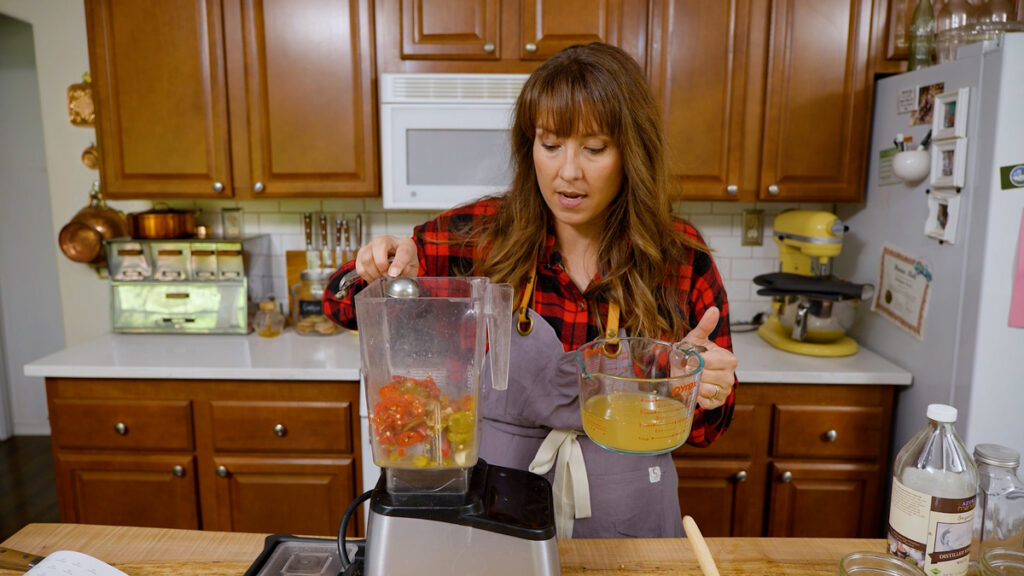
What Is Fermented Food
I like to tell people that when you’re fermenting, you’re being a farmer, except your garden is a jar or a vessel, and the plants you’re trying to grow are actually your bacteria. The bacteria is unique in each person’s home, kitchen, veggie garden and geographic location.
You need to ensure you’re growing the good plants or the good bacteria and suppressing the bad plants or weeds. Learn about Kahm yeast, which is harmless but can change the flavor of the ferment and other bacteria or molds that are harmful. This four – pack airlock system helps prevent mold growth; it works really well.
Research shows fermented foods have anti-microbial, anti-carcinogenic benefits and probiotics, which aid in our gut health, allowing us to strengthen our immune system. (Source)
When the lactobacillus bacteria start multiplying, they eat the sugars and carbohydrates in your food and turn that into lactic acid. That lactic acid bacteria then preserves the food in the state that it’s in. Lactobacillus kills bad bacteria and survives in the brine, giving us it’s good bacteria. (Source)
Fermented vegetables are probably one of the easiest forms of fermentation (and food preservation) you can start with. It’s as simple as mixing some vegetables and submerging them in saltwater brine at room temperature from three days up to two or more weeks.
Not all ferments are alike! In fact, there are three kinds of fermentation, and all three are easy to do and specific to differing types of foods. Fermentation adds essential probiotics to your intestines and increases gut health when done correctly. (Source)

Three Kinds of Fermentation
- Lactic Acid Fermentation – This type of fermentation happens when naturally occurring yeast and bacteria convert sugars into lactic acid. This naturally preserves the food for long-term storage (as long as proper temperatures are maintained) and is the typical form used for fermented vegetables.
- Ethyl Alcohol – The most common forms of ethyl alcohol fermentation are beer, wine, hard cider, and other alcoholic beverages. These ferments use yeast to break down starches and sugars and transform them into carbon dioxide, which gives your ferment that nice bubbly effect we all love so much.
- Acetic Acid – This method of fermentation occurs when starch from grains and sugars from fruit ferment. This is the case for foods like apple cider vinegar, homemade fruit vinegar, kombucha, water kefir, and milk kefir.
How long a specific ferment takes to finish is dependent on your taste preference and the ingredients used. Sauerkraut can ferment for 2-4 weeks, and the flavors change throughout the process. It can then be moved to cold storage to sit for 6+ months for the flavors to develop and mellow out a bit. It’s really about your preferred taste!
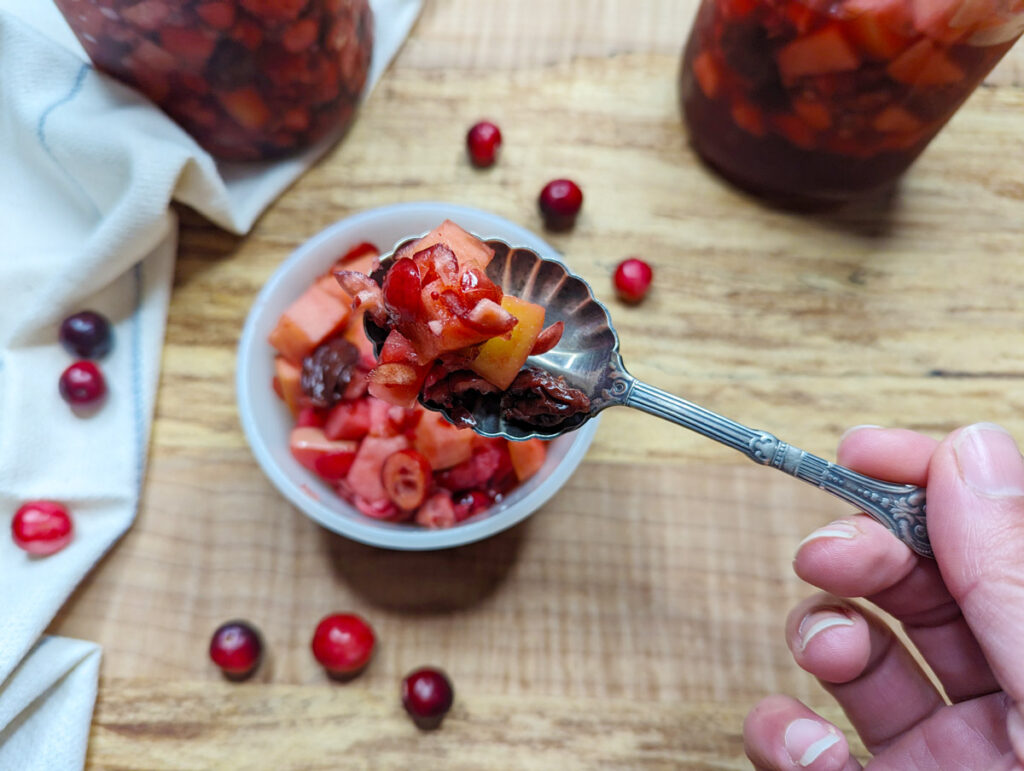
How to Get Your Kids Excited About Healthy Food
When my kids have a hand in planting, tending to the garden, harvesting and preserving our food, they are more open to eating it. I like introducing a new vegetable each year to liven things up a bit, and my kids enjoy trying the new addition.
I found it’s best to try new foods in small bites! The great thing about fermented foods is a small amount is beneficial, so it’s a good place to start. My homemade buttermilk ranch dressing with probiotics from the buttermilk is a favorite with kids. Just add veggies and start dipping!
Fermented foods that my kids enjoyed right off the bat are carrots and cucumbers, which are naturally a little sweeter. The longer foods ferment, the stronger the taste, so when you’re starting out, eat the fermented food sooner rather than later.
You may also want to try some of the sweeter ferments, like fermented cranberry sauce (pictured above).

Benefits of Fermented Foods
The health benefits of fermented foods are amazing. This process has been around for so long, yet we are embracing the gut benefits of healthy microbiota in our intestines through fermentation in recent years. These are some of the most astounding benefits of fermented foods.
- Probiotics – These live microorganisms are formed when fermenting foods and are beneficial for our gut microbiome. It’s proven to help with different bowel diseases and overall health. (Source)
- Micronutrients and Macronutrients – Since your food fermented food is raw, all of these valuable gut-healthy nutrients stay in there, because you’re not cooking any of them out.
- Vitamins and Enzymes – Fermented dairy products positively impact intestinal health due to the absorption of vitamins and enzymes that help the gut digest other healthy food more efficiently. (Source)
- Lactobacillus – This good gut-healthy bacteria colonize when the food ferments while hunting down and killing the bad bacteria. The benefit of this process increases the quality of good bacteria in our intestines to absorb more nutrients from healthy foods we eat. (Source)
- Overall Health Benefits – Eating fermented foods is linked to lowering inflammation and blood pressure, easing irritable bowel syndrome, and stabilizing blood sugar levels for those with type 2 diabetes. (Source) (Source)
- Energy Efficient – This food preservation method is energy efficient in the kitchen and our bodies. You don’t need electricity, propane or any heat source, just time to ferment. I have more energy from the increased enzymes as well; it’s really amazing!
- Time Saver – As a food preservation method, it’s so quick and simple, and that’s one thing I love about it. You submerge the food of choice in the brine, cover it up, and set it on a shelf for as long as you want to achieve your desired taste.
- Gut- Repair – Probiotics and digestive enzymes in fermented foods help your intestines heal, causing foods to be easier to digest and readily absorb healthy vitamins and enzymes. Issues like leaky gut or other digestive health issues, where your intestines don’t absorb nutrients, can heal with fermented food. (Source)
It’s important to note that I am not a certified medical practitioner. This post is not intended to diagnose or treat but is for informational purposes only. Please contact your healthcare professional before introducing new herbal and natural remedies into your wellness routine.
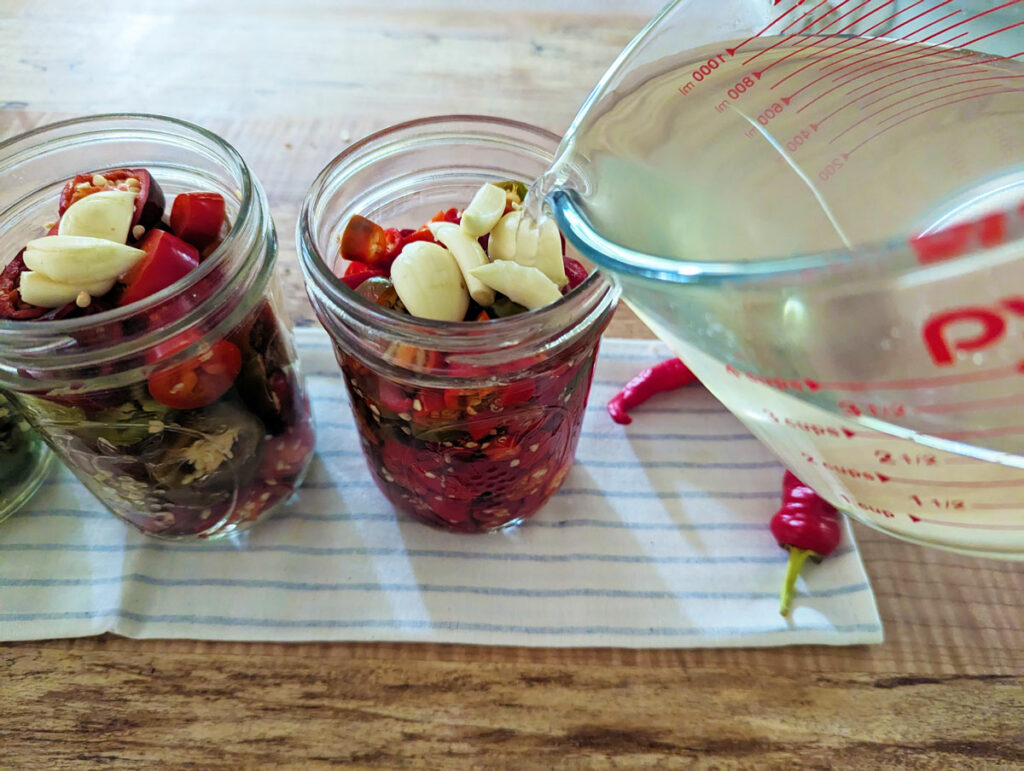
FAQs
Can I make a big batch of brine?
Absolutely, and at times, it makes the process go even faster when you have it premade in a glass jar or crock on a shelf, ready for use! If it’s going to be around for longer than a few days, keep it in the fridge, but bring it to room temperature before making a fresh batch. I find it’s just so simple and quick to make while preparing a fresh batch of fermented food, so I make it as needed.
What size vessel do you use when fermenting?
When fermenting foods, I prefer wide-mouth glass mason jars of various sizes. Depending on the food and amount of food you’re fermenting would dictate the size you would use. I am a mason jar junky, and they are my go-to when fermenting. You can use crocks, and there are specific glass fermenting vessels for this process in many sizes. I don’t recommend aluminum or metal vessels of any size for fermentation.
How do I know when my fermented food is bad?
Your sense of smell will alert you if your ferment has gone bad. If it smells odd, and you will know, my friend, you won’t want to eat it because it will smell awful.
The appearance will also alert you to the fact it’s gone bad. If there is a white mold on top, that is usually ok, scrape it off and enjoy! If there are colored molds that are green, black, pink or any other strange color, let it go to the compost pile or throw it away.
Does all fermented food taste the same?
There are over 150 different strains of lactobacillus bacteria. The bacteria you have at your home will be different than the ones I’ve got in my part of the country in my home. Your ferment will be unique to your environment and taste slightly different than anyone else’s. The amount of time you ferment your food will also dictate the taste, and the temperature at which it’s fermented will factor in as well.
Is It Good to Eat Fermented Food Everyday?
Studies have shown that eating fermented food daily does improve gut health. It’s best to start out with small portions to allow your body to adapt. Too much too soon can give you some gassy side effects. As you add more fermented foods to your daily diet your body will adapt and be the healthier for it.
Are Fermented Foods Anti-Inflammatory?
Yes, the anti-inflammatory properties in most fermented foods have been shown to improve overall gut health. (Source)
How do I know when my fermented food is bad?

Resources:
- Where to Find Carolyn
- Fermenting Recipe – Fermented Pickles – Quick & Easy Old-Fashioned Recipe
- Airlock Fermenting System -These airlock systems help keep bad bacteria out and reduce the risk of mold. I have used these for several years–> 4-pack airlock system
- Verse of the Week – Joshua 1:6-7
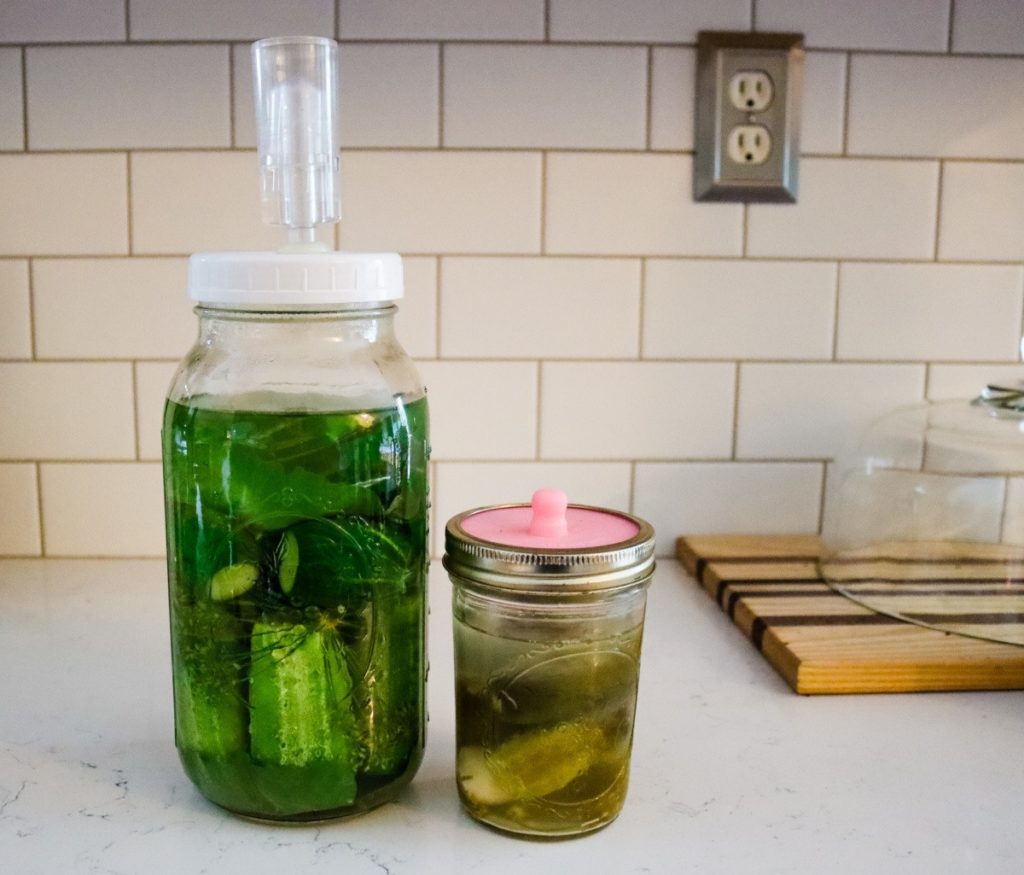
Other Posts You May Enjoy
- Kahm Yeast (What, Why & Does it Ruin a Ferment)
- How to Ferment Peppers
- Fresh Fermented Salsa Recipe
- Fermented Pickles – Quick & Easy Old-Fashioned Recipe
- The Best Fermented Hot Sauce Recipe
- How to Make Homemade Fruit Vinegar
- How to Store Lemons (For a Year!) – Fermented Lemons
- Fermented Cranberry Sauce
